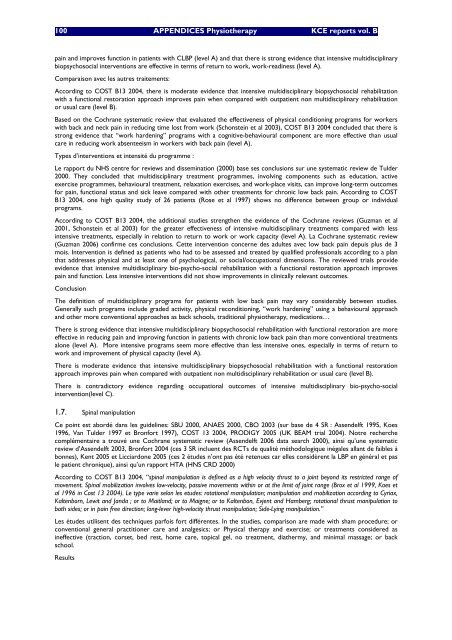Download the supplement (208 p.) - KCE
Download the supplement (208 p.) - KCE
Download the supplement (208 p.) - KCE
You also want an ePaper? Increase the reach of your titles
YUMPU automatically turns print PDFs into web optimized ePapers that Google loves.
100 APPENDICES Physio<strong>the</strong>rapy <strong>KCE</strong> reports vol. B<br />
pain and improves function in patients with CLBP (level A) and that <strong>the</strong>re is strong evidence that intensive multidisciplinary<br />
biopsychosocial interventions are effective in terms of return to work, work-readiness (level A).<br />
Comparaison avec les autres traitements:<br />
According to COST B13 2004, <strong>the</strong>re is moderate evidence that intensive multidisciplinary biopsychosocial rehabilitation<br />
with a functional restoration approach improves pain when compared with outpatient non multidisciplinary rehabilitation<br />
or usual care (level B).<br />
Based on <strong>the</strong> Cochrane systematic review that evaluated <strong>the</strong> effectiveness of physical conditioning programs for workers<br />
with back and neck pain in reducing time lost from work (Schonstein et al 2003), COST B13 2004 concluded that <strong>the</strong>re is<br />
strong evidence that work hardening programs with a cognitive-behavioural component are more effective than usual<br />
care in reducing work absenteeism in workers with back pain (level A).<br />
Types d interventions et intensité du programme :<br />
Le rapport du NHS centre for reviews and dissemination (2000) base ses conclusions sur une systematic review de Tulder<br />
2000. They concluded that multidisciplinary treatment programmes, involving components such as education, active<br />
exercise programmes, behavioural treatment, relaxation exercises, and work-place visits, can improve long-term outcomes<br />
for pain, functional status and sick leave compared with o<strong>the</strong>r treatments for chronic low back pain. According to COST<br />
B13 2004, one high quality study of 26 patients (Rose et al 1997) shows no difference between group or individual<br />
programs.<br />
According to COST B13 2004, <strong>the</strong> additional studies streng<strong>the</strong>n <strong>the</strong> evidence of <strong>the</strong> Cochrane reviews (Guzman et al<br />
2001, Schonstein et al 2003) for <strong>the</strong> greater effectiveness of intensive multidisciplinary treatments compared with less<br />
intensive treatments, especially in relation to return to work or work capacity (level A). La Cochrane systematic review<br />
(Guzman 2006) confirme ces conclusions. Cette intervention concerne des adultes avec low back pain depuis plus de 3<br />
mois. Intervention is defined as patients who had to be assessed and treated by qualified professionals according to a plan<br />
that addresses physical and at least one of psychological, or social/occupational dimensions. The reviewed trials provide<br />
evidence that intensive multidisciplinary bio-psycho-social rehabilitation with a functional restoration approach improves<br />
pain and function. Less intensive interventions did not show improvements in clinically relevant outcomes.<br />
Conclusion<br />
The definition of multidisciplinary programs for patients with low back pain may vary considerably between studies.<br />
Generally such programs include graded activity, physical reconditioning, work hardening using a behavioural approach<br />
and o<strong>the</strong>r more conventional approaches as back schools, traditional physio<strong>the</strong>rapy, medications<br />
There is strong evidence that intensive multidisciplinary biopsychosocial rehabilitation with functional restoration are more<br />
effective in reducing pain and improving function in patients with chronic low back pain than more conventional treatments<br />
alone (level A). More intensive programs seem more effective than less intensive ones, especially in terms of return to<br />
work and improvement of physical capacity (level A).<br />
There is moderate evidence that intensive multidisciplinary biopsychosocial rehabilitation with a functional restoration<br />
approach improves pain when compared with outpatient non multidisciplinary rehabilitation or usual care (level B).<br />
There is contradictory evidence regarding occupational outcomes of intensive multidisciplinary bio-psycho-social<br />
intervention(level C).<br />
1.7. Spinal manipulation<br />
Ce point est abordé dans les guidelines: SBU 2000, ANAES 2000, CBO 2003 (sur base de 4 SR : Assendelft 1995, Koes<br />
1996, Van Tulder 1997 et Bronfort 1997), COST 13 2004, PRODIGY 2005 (UK BEAM trial 2004). Notre recherche<br />
complémentaire a trouvé une Cochrane systematic review (Assendelft 2006 data search 2000), ainsi qu une systematic<br />
review d Assendelft 2003, Bronfort 2004 (ces 3 SR incluent des RCTs de qualité méthodologique inégales allant de faibles à<br />
bonnes), Kent 2005 et Licciardone 2005 (ces 2 études n ont pas été retenues car elles considèrent la LBP en général et pas<br />
le patient chronique), ainsi qu un rapport HTA (HNS CRD 2000)<br />
According to COST B13 2004, spinal manipulation is defined as a high velocity thrust to a joint beyond its restricted range of<br />
movement. Spinal mobilization involves low-velocity, passive movements within or at <strong>the</strong> limit of joint range (Brox et al 1999, Koes et<br />
al 1996 in Cost 13 2004). Le type varie selon les etudes: rotational manipulation; manipulation and mobilization according to Cyriax,<br />
Kaltenborn, Lewit and Janda ; or to Maitland; or to Maigne; or to Kaltenbon, Evjent and Hamberg; rotational thrust manipulation to<br />
both sides; or in pain free direction; long-lever high-velocity thrust manipulation; Side-Lying manipulation.<br />
Les études utilisent des techniques parfois fort différentes. In <strong>the</strong> studies, comparison are made with sham procedure; or<br />
conventional general practitioner care and analgesics; or Physical <strong>the</strong>rapy and exercise; or treatments considered as<br />
ineffective (traction, corset, bed rest, home care, topical gel, no treatment, dia<strong>the</strong>rmy, and minimal massage; or back<br />
school.<br />
Results
















